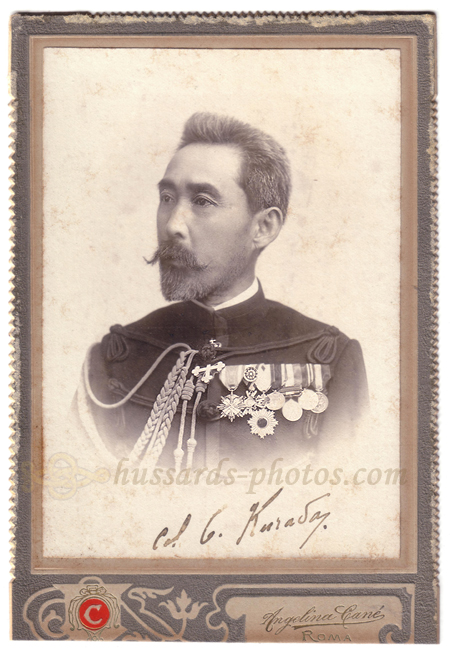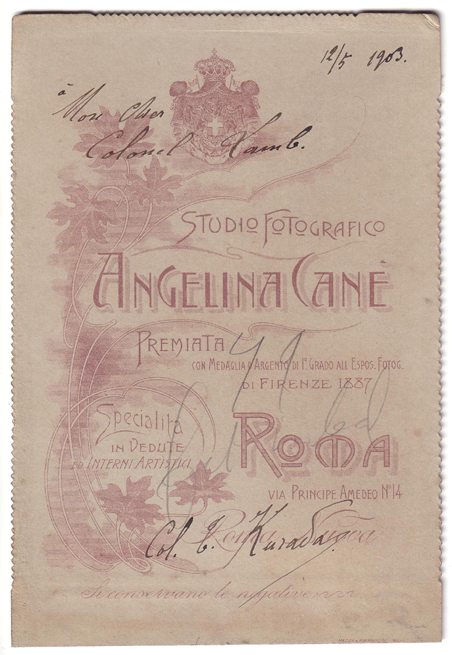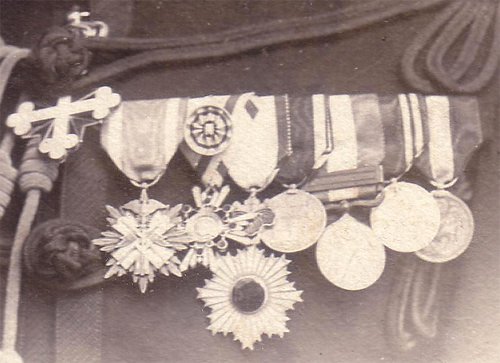Cette photographie est
dédicacée le 12 Mai 1903 "à mon cher Colonel Lamb".
Il s'agit du Lieutenant-Colonel Charles
Anthony Lamb, Attaché
Militaire de l'Ambassade de Grande Bretagne à Rome.
Né le 21 Mars 1857, il est le fils de Charles
James Saville Montgomerie Lamb et d'Anna Charlotte Grey.
Il étudie à Cheltenham et à l'Académie Royale Militaire de
Sandhurst, avant d'être nommé Sub-Lieutenant le 11 Février
1875 au 64th Regiment.
Promu Lieutenant le 11 février 1876, il est transféré dans la Rifle
Brigade le 12 Août.
Il passera Captain le 1er Août 1884.
Le 15 Janvier 1891, il quitte le Dépôt du 2nd Battalion de la Brigade
pour prendre les fonctions d'Adjutant du corps des 20th
Middelsex (Artist's) Royal Volunteers.
Il est promu Major le 15 Octobre 1893.
En 1896 on le retrouve au dépôt de la Rifle Brigade, à Gosport.
le 26 Août 1898, il quitte le Dépôt de la Rifle Brigade pour
prendre le poste de Second in Command du 2nd Battalion de
la Brigade, basé à Malte.
L'année suivante, il est attaché au 1st
Battalion, qui mobilise pour prendre part à la Guerre des Boers.
Les réservistes sont rappelés, et le Major Lamb leur dispense un
rapide cours de Musketry.
Le Battalion embarquera le 28 Octobre à Cowes à bord de deux
vapeurs qui les mènent à Southampon, où ils se transbordent sur le German,
qui les emmène en Afrique du Sud.
Ils rejoignent le Cap le 20 Novembre à midi - le surlendemain le Nubia
les transfère à Durban.
De là ils rejoindront Pietermatritzburg (25 Novembre), d'où ils
marcheront pour rejoindre la 4e Brigade (Major-General Lyttleton) le 3
Décembre.
Cette Brigade jouera un rôle de support à la bataille de Colenso le 15
Décembre.
Le 1st Battalion sera engagé le 5 Février 1900 à la bataille
de Val Krantz, qu'ils prennent d'assaut et dont ils chassent les Boers ;
Lamb commande les quatre compagnies de droite qui auront "a hot
time" :
"Four companies, under Major Lamb, then
emerged upon the open veldt and mealie fields, and, swinging well round
to the right, made straight for the farmhouse, while the Colonel, with
the remaining four companies, keeping in touch, followed in the track of
the Durhams.
The advance was splendidly led and magnificently carried through. There
was no staying the onward march of that thin khaki-clad line, though the
broad leaves of the mealie plants were being flipped incessantly by
bullets coming, not from one direction alone, but from everywhere except
Swartz Kop. When they had passed the pontoon, and made a right turn to
face their objective, they necessarily had the long broken spurs of
Doornkloof, running up to a high peak, on which the 100-pounder gun was
placed later on, right in their rear. Thus they had Mausers to the right
of them, Mausers in front of them, and Mausers behind of them, sending a
deadly hail of winged death, while the Maxim automatic upon the kloof
raked the leading sections with its projectiles. It was an Inferno of
lead that they could not locate, for, hidden as the enemy was, they
could not, even if they had time, clear the waspish lines of the
concealed enemy. All they could do, and all they did, was to advance
calmly on, as British soldiers should, and drive the Boers from their
immediate front.
Had the enemy been the dead shots they are credited with being, Lamb's
four Companies, right within the zone of the half-circle of rifle fire,
would have been swept out of existence. Now and again a soldier,
stricken to the ground, dropped out of the ranks, and here and there two
or more would get in the way of the flying bullets, throw up their
hands, and lie where they fell, with shattered limbs, through the long,
long night, until the ambulance men came in the morning to carry them to
the tented hospital. Their luckier comrades, every nerve strained, eyes
front, moved ever onwards. Before them lay farm walls sheltering the
enemy—long, low, boulder erections, the very thing for a sharpshooter.
Further in the near distance, below Vaal Kop farm, rose a small kopje
belching fire. Further on again, to the right of the kopje, and almost
in the centre of the valley, a Maxim quick-firer lay well concealed in a
donga, and between the farmhouse and the top end of the valley there was
a never-ending roll of musketry. As if that were not enough, the gun
firing from the point where the tableland began at the top of the kloof,
and just outside the range of our guns on the flat, kept pitching shell
after shell at the Rifle Brigade.
When the Durhams had about reached the base of Vaal Kop the Rifle
Brigade had succeeded, on their right, in routing the Boers from the
farm walls. Then, sweeping round to the left, they, with a cheer,
cleared a small kopje of the enemy and forced the Maxim-automatic, which
was fully horsed, to retire into the neighbourhood of the kloof. Having
accomplished all he could possibly do that afternoon at least, Major
Lamb led his men up the side of Vaal Kop, and passed through the gap
connecting it and the succeeding ridge. Simultaneously, the other
half-battalion, with Colonel Norcott, had reached the gap, to find the
Durhams by this time proceeding along the crest to the next knoll. Two
other battalions, who also had o work their way from the pontoon under
fire to Vaal Kop, shortly after reached the latter position and occupied
it. The remaining portion captured the ridge.
The Devons, meanwhile, had been sent on to occupy the farmhouse, which
had been gallantly cleared by a half- battalion of the Eifle Brigade,
and held it until next evening, when, having been relieved by the
Connaught Rangers, they in turn passed over Vaal Krantz and joined
Hildyard's Brigade there, remaining until the subsequent evacuation on
Wednesday night." (in "The Rifle Brigade Chronicle for
1900")
Le 10 février, le Major Lamb prend le
commandement du 1st Battalion - qui marche de Springfield à Pretorius
Farm (le Colonel Norcott prenant le commandement de la Brigade
Légère et le Général Lyttelton celui de la division).
Le 1st Battalion prendra part à la bataille de Monte Cristo, le 18
Février, puis de Pieter's Hill, le 27, dans la marche pour secourir
Ladysmith, où il rentre le 3 Mars 1900.
Le Major Lamb est nommé Attaché Militaire à
l'Ambassade de Rome, le 4 février 1901, et le lendemain, promu Lieutenant-Colonel
en demi-solde.
En 1902 il reçoit la Coronation Medal.
En Avril 1903, peu avant que le Colonel Kurada lui dédicace cette
photo, il accompagne son souverain Edouard VII lors de sa visite
officielle à Rome. A cette occasion, le Roi le fait Member of the
Royal Victorian Order (M.V.O.) le 28 Avril - le Roi Victor Emmanuel
le faisant Commandeur de l'Ordre des St. Maurice et Lazare pour faire
bonne mesure.
Le 10 Février 1904, il recevra le Brevet de
Colonel.
Il se retirera en Février 1906, mais reprendra du service comme
Attaché Militaire lors de la Première Guerre Mondiale.
Les "valuable services" qu'il rendra alors lui vaudront
d'être fait Companion de l'ordre de Saint Michael et Saint
Georges en Avril 1918.
Il succèdera au titre de Baronet le 6
Novembre 1921, à la mort de son frère aîné Archibald.
Charles Anthony Lamb décèdera le 28 Juillet 1948 - le titre de 'Baronet
Lamb' s'éteignant avec lui.
Il avait épousé Lelia Frances Adamson le 30 Décembre 1886. |




